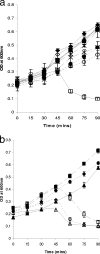Identification and characterization of lactococcal-prophage-carried superinfection exclusion genes
- PMID: 18723645
- PMCID: PMC2570291
- DOI: 10.1128/AEM.01053-08
Identification and characterization of lactococcal-prophage-carried superinfection exclusion genes
Abstract
Superinfection exclusion (Sie) proteins are prophage-encoded phage resistance systems. In this study, genes encoding Sie systems were identified on the genomes of Lactococcus lactis subsp. cremoris MG1363 and L. lactis subsp. lactis IL1403. These Sie systems are genetically distinct and yet were shown to act specifically against a particular subset of the 936 phage group. Each of the systems allows normal phage adsorption while affecting plasmid transduction and intracellular phage DNA replication, which points to the blocking of phage DNA injection as their common mode of action. Sie-specifying genes found on the MG1363 prophages are also present in various lactococcal strains, whereas the prophage-encoded Sie systems of IL1403 do not appear to be as widely disseminated.
Figures



References
-
- Brondsted, L., S. Ostergaard, M. Pedersen, K. Hammer, and F. K. Vogensen. 2001. Analysis of the complete DNA sequence of the temperate bacteriophage TP901-1: evolution, structure, and genome organization of lactococcal bacteriophages. Virology 283:93-109. - PubMed
-
- Chandry, P. S., S. C. Moore, J. D. Boyce, B. E. Davidson, and A. J. Hillier. 1997. Analysis of the DNA sequence, gene expression, origin of replication and modular structure of the Lactococcus lactis lytic bacteriophage sk1. Mol. Microbiol. 26:49-64. - PubMed
Publication types
MeSH terms
Substances
LinkOut - more resources
Full Text Sources
Other Literature Sources

